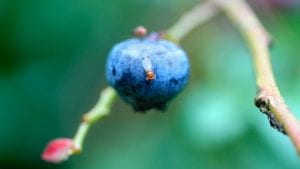
Cornell Chronicle [2019-08-06]
With New York state’s $20 million berry industry entering peak season, an invasive fruit fly is thriving.
Female spotted-wing drosophila (Drosophila suzukii Matsumura) have a special ovipositor (a tube through which a female insect deposits eggs) with a saw-like end that allows them to cut into soft fruits and insert their eggs. The larvae and adults feed on the fruits, causing billions of dollars in damage across Asia, North and South America, and Europe.
But little has been known about how the pests survive before and after the growing season.
A Cornell study, published in May in Ecological Entomology, investigates for the first time what spotted-wing drosophila adults and larvae eat, and where they lay their eggs, when these short-lived fruits are not in season.
“They will lay eggs and successfully develop on less preferred resources and not the typical fruit that we think they prefer,” said Greg Loeb, professor of entomology at Cornell AgriTech and a co-author of the paper. Dara Stockton, a postdoctoral associate in Loeb’s lab, is the paper’s first author.


